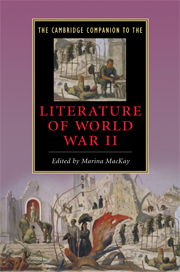3 - War poetry in the USA
from Part I - Anglo-American texts and contexts
Published online by Cambridge University Press: 28 May 2009
Summary
In 2003, Harvey Shapiro edited an anthology called Poets of World War II as part of the American Poets Project published by The Library of America. In his introduction he expresses his regret that “common wisdom has it that the poets of World War I - Wilfred Owen, Robert Graves, Siegfried Sassoon, Edmund Blunden, Isaac Rosenberg - left us a monument and the poets of World War II did not” (p. xx). Given America's late entry into the war in 1917, little of the monumental poetry of the Great War was written by Americans. Shapiro writes, “The American poets of World War I - John Peale Bishop, E. E. Cummings, Archibald MacLeish, Alan Seeger - were too few to constitute a group” (p. xx). This imbalance in the poetic production of war poetry should have been redressed in World War II, although here a different set of impediments intervened. Paul Fussell suggests two reasons why the war produced more silence than poetic expression. The first was the sheer magnitude of violence and the level of cruelty produced by the war. “Faced with events so unprecedented and so inaccessible to normal models of humane understanding, literature spent a lot of time standing silent and aghast.” The second was that redemptive notions of patriotism, heroism, and even elegiac sentiment had been effectively exhausted by World War I. “It is demoralizing to be called on to fight the same enemy twice in the space of twenty-one years, and what is there to say except what has been said the first time?” Fussell writes. And yet poetry was produced in response to World War II, including a wide range of American poetry, as Shapiro's anthology demonstrates. Taken as a whole, these poems exemplify another reason why their response to World War II has not achieved the same public visibility and cultural significance as the poetry of the Great War.
- Type
- Chapter
- Information
- Publisher: Cambridge University PressPrint publication year: 2009
- 1
- Cited by

